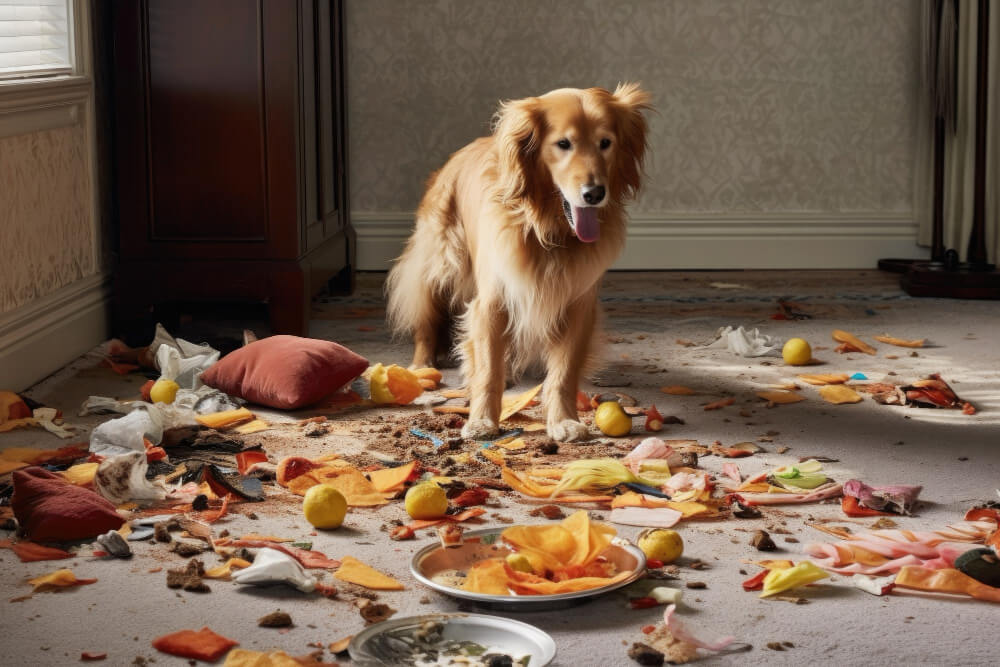Food aggression in dogs is a troubling behavior that many pet owners face. It manifests as growling, snapping, or biting when their food is approached or threatened. Understanding how to stop food aggression in dogs is crucial for maintaining a peaceful and safe environment at home.
This blog post will show you how to stop dog food aggression. For that, we'll use easy steps and clear advice to help your furry friend eat peacefully.
Understanding Food Aggression in Dogs

Before diving into solutions, it's important to grasp why dogs exhibit food aggression. This behavior often stems from instinct, where in the wild, dogs had to compete for meals. Although domesticated, some dogs still feel the need to guard their food fiercely. Recognizing the signs of food aggression, such as stiffening, growling, or snapping, is the first step toward addressing the problem.
How To Fix Food Aggression In Dogs

Now that we've covered the basics of understanding food aggression, let's dive into how to fix it. With the right approach and techniques, turning tense meals into peaceful times is within reach.
Establishing Trust and Leadership
To stop food aggression in dogs, building trust and showing you're the leader is key. Dogs are pack animals and naturally look for a leader. You need to be that leader but in a kind way. This doesn't mean being harsh. It's about being steady and calm, especially around food. Show your dog that you're in charge by setting rules and sticking to them. But always be gentle and patient.
Next, strengthen your bond through regular, positive interactions. Spend time playing, walking, and training your dog. This not only builds trust but also helps your dog see you as a friend and leader. When it comes to feeding time, your dog will start to understand that you control the food. This realization is a big step in fixing food aggression because it shows your dog that there's no need to guard their food from you, their trusted leader.
Gradual Desensitization
radual desensitization is a gentle way to help your dog stop being aggressive around food. Start by staying a bit away from your dog while they eat. Slowly, day by day, get a little closer. The idea is to make your dog see that you being near their food is okay. They need to learn that coming closer doesn't mean their food is in danger.
As you get closer over time, you can start to add treats to their bowl while they're eating. This teaches them something great: people near their food can mean extra goodies, not a threat. This step is crucial because it changes how your dog thinks about mealtime. Instead of worry or fear, your dog starts to feel calm and even happy when you're around during meals. This change in mindset is a big win in overcoming food aggression.
Hand Feeding and Adding Food
Hand feeding is a powerful method to combat food aggression. It involves directly giving your dog food from your hand instead of placing it in a bowl. This process builds a strong bond between you and your dog, showing them that you are a provider, not a threat. It also allows you to control the eating process, reinforcing calm and submissive behavior.
After some time, as your dog becomes more comfortable, you can begin to place food in their bowl, then occasionally add more food with your hand while they eat. This action reinforces the idea that your approach means more food, not less, promoting a positive association with your presence during meal times.
Training Commands
Incorporating training commands into your strategy can significantly help manage food aggression. Teaching your dog commands like "leave it," "sit," or "wait" before eating can instill discipline and patience. Use a calm and firm tone, rewarding compliance with praise or a treat.
Practicing these commands daily reinforces respect and understanding between you and your dog. This respect helps diminish their need to aggressively guard their food since they start to trust your command over their instinct to protect.
Control the Environment
Managing the environment where your dog eats can drastically reduce food aggression. Feeding your dog in a quiet, distraction-free area helps them feel safe and relaxed during meal times. If you have multiple pets, feeding them separately can prevent competitive behavior and aggression. Also, ensure your dog's eating area is comfortable and secure, further associating mealtime with positive experiences.
By controlling these aspects of the environment, you can help minimize the triggers of food aggression, making meal times peaceful and enjoyable for your dog.
Consult a Professional
Sometimes, despite your best efforts, you might need extra help. If you still worry about how to stop food aggression in dogs, it's wise to consult a professional dog trainer or behaviorist. These experts understand dog behavior deeply and can offer personalized advice. They have the experience to spot subtle signs of aggression and know how to address them safely and effectively.
After evaluating your dog, a professional creates a dog food aggression training plan. This plan could include specific exercises and routines designed just for your dog's needs. They can also teach you how to communicate with your dog better, building a stronger bond and reducing aggression. Working with a professional doesn't just address the symptoms of food aggression; it helps get to the root of the problem, ensuring lasting change.
Conclusion
Understanding how to stop food aggression in dogs and tackling it requires patience, understanding, and consistency. By establishing trust and employing training techniques, you can transform tense meal times into peaceful ones. If you find yourself struggling, don't hesitate to seek help from a professional. They can provide invaluable guidance and support tailored to your dog's unique needs. Ultimately, you'll see a significant improvement in your dog's behavior.




